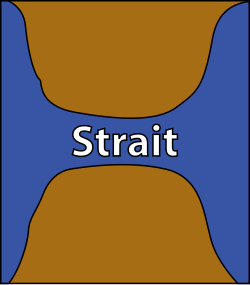Top Qs
Timeline
Chat
Perspective
Strait
Waterway that connects two larger bodies of water From Wikipedia, the free encyclopedia
Remove ads
A strait is a water body connecting two seas or water basins. The surface water is, for the most part, at the same elevation on both sides and can flow through the strait in either direction, although the topography generally constricts the flow somewhat. In some straits, there is a dominant directional current. Most commonly, the strait is a narrow channel that lies between two land masses. Straits are loci for sediment accumulation, with sand-sized deposits usually occurring on the two strait exits, forming subaqueous fans or deltas. Some straits are not navigable because, for example, they are too narrow or too shallow, or due to the presence of a reef or archipelago.
This article needs additional citations for verification. (June 2010) |


Remove ads
Terminology

The terms channel, pass, or passage can be synonymous and used interchangeably with strait, although each is sometimes differentiated with varying senses. In Scotland, firth or Kyle are also sometimes used as synonyms for strait.
Many straits are economically important. Straits can be important shipping routes and wars have been fought for control of them.
Numerous artificial channels, called canals, have been constructed to connect two oceans or seas over land, such as the Suez Canal. Although rivers and canals often provide passage between two large lakes, and these seem to suit the formal definition of strait, they are not usually referred to as such. Rivers and often canals, generally have a directional flow tied to changes in elevation, whereas straits often are free flowing in either direction or switch direction, maintaining the same elevation. The term strait is typically reserved for much larger, wider features of the marine environment. There are exceptions, with straits being called canals; Pearse Canal, for example.
Remove ads
Comparisons
Straits are the converse of isthmuses. That is, while a strait lies between two land masses and connects two large areas of ocean, an isthmus lies between two areas of ocean and connects two large land masses.
Some straits have the potential to generate significant tidal power using tidal stream turbines. Tides are more predictable than wave power or wind power. The Pentland Firth (a strait) may be capable of generating 10 GW.[1] Cook Strait in New Zealand may be capable of generating 5.6 GW[2] even though the total energy available in the flow is 15 GW.[3]
Remove ads
Navigational (legal) regime
Straits used for international navigation through the territorial sea between one part of the high seas or an exclusive economic zone and another part of the high seas or an exclusive economic zone are subject to the legal regime of transit passage (Strait of Gibraltar, Strait of Dover, Strait of Hormuz). The regime of innocent passage applies in straits used for international navigation (1) that connect a part of high seas or an exclusive economic zone with the territorial sea of a coastal nation (Straits of Tiran, Strait of Juan de Fuca, Strait of Baltiysk) and (2) in straits formed by an island of a state bordering the strait and its mainland if there exists seaward of the island a route through the high seas or through an exclusive economic zone of similar convenience with respect to navigational and hydrographical characteristics (Strait of Messina, Pentland Firth). There may be no suspension of innocent passage through such straits.[4]
See also
References
Bibliography
External links
Wikiwand - on
Seamless Wikipedia browsing. On steroids.
Remove ads
